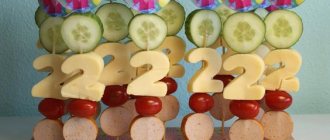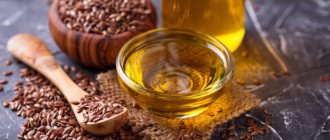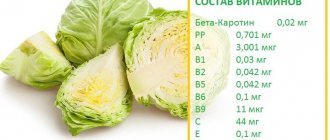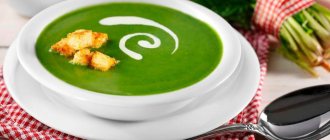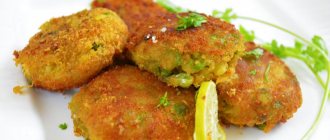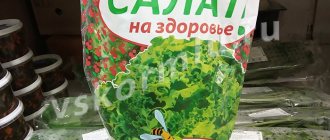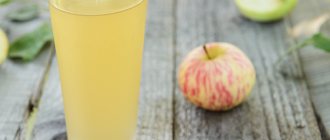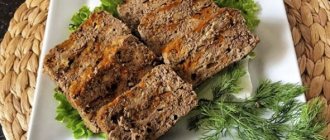Useful properties and composition
Salad leaves with an incredibly low amount of calories (only 14-18 kcal depending on the variety) are easily and quickly digested, and are also included in the list of products with minimal allergic risk. Thanks to its rich composition, greens will diversify the menu and bring many benefits:
- B vitamins normalize the functioning of the nervous system;
- Vitamin C strengthens the body’s defense system, which is important during colds;
- vitamins A and E are rightly called guardians of beauty - they restore the structure of the skin, nails and hair, and help improve vision;
- Niacin is considered the best prevention of depression and cardiovascular diseases;
- calcium contained in lettuce during breastfeeding strengthens bone tissue;
- sodium is responsible for maintaining water-salt balance;
- zinc controls blood sugar levels and starts metabolic processes.
Women who regularly eat green leaves note:
- normalization of sleep;
- memory improvement;
- restoration of the gastrointestinal tract.
When asked whether it is possible to eat iceberg lettuce while breastfeeding, experts answer positively - it has a beneficial effect on the body, like leafy greens. However, it is worth limiting its consumption in case of kidney, liver and bladder diseases due to the high content of oxalic acid in the product.
How to introduce and in what form to eat lettuce during lactation?
When updating the menu, we should not forget that even a seemingly safe dish can provoke an allergic reaction in an infant. During the first 4-5 weeks after birth, it is necessary to adhere to strict dietary restrictions, and green salad leaves can be introduced during breastfeeding from 6 weeks. You should not drink the salad because the plant is 90% water, and adding liquid will cause stomach upset.
The following combinations create harmonious taste and benefits:
- 50 grams of salad and boiled eggs;
- leaves and low-fat cottage cheese;
- greens and fish or lean meat.
It is advisable to eat 1-2 leaves for breakfast and monitor the baby’s health. New products should not be introduced for another 48 hours to accurately determine the child’s body’s reaction to the probable allergen:
- itching;
- swelling;
- redness and rashes on the skin;
- rhinitis;
- colic;
- stool disorders.
Food allergies may not appear immediately, but any deviations should alert you.
Lettuce leaves during breastfeeding should be consumed carefully:
- You should not eat them on an empty stomach, so as not to provoke an increase in appetite.
- A serving should not exceed 150-200 g. A large amount of fiber leads to bloating and increased gas formation in the mother, colic and pain in the baby.
- Before adding to dishes, the leaves must be thoroughly washed; it is better to discard the top ones. The last recommendation concerns the iceberg variety.
Important! A few drops of olive or sunflower oil are suitable as a salad dressing for a nursing mother. Vinegar, soy and other hot or fatty sauces are excluded from the diet during breastfeeding.
Useful tips
Adviсe:
- For salads for nursing women, you need to buy lean meat, such as chicken breast, beef, turkey. You should boil it yourself. But smoked, dried, and other similar products should not be used in the menu of breastfeeding women.
- Fish salads should be treated with caution. Such snacks can cause an allergic reaction in infants.
- It is very useful for a woman after childbirth to eat various offal products, such as chicken hearts or liver.
- Brightly colored fruits and vegetables, such as red apples, tomatoes, and orange citrus fruits, can trigger allergies in your baby. Therefore, it is preferable to choose green fruits (cucumbers, apples, green beans).
- It is advisable to consume cod, pollock, and pike perch in the first months of lactation. Hake is also suitable. Later, mackerel and herring are introduced into the menu. The fish is baked in the oven or boiled.
- Snacks including smoked and salted fish are not recommended. The same applies to crab sticks, canned food, and preserves.
- Zucchini, broccoli, and squash are allowed to be added to food immediately after the birth of the child. Potatoes, pumpkin, and green beans are also suitable. Then the diet includes cucumbers, green bell peppers and corn. Then you can eat carrots, beets, and lettuce.
- Snacks can include different fruits: apples, pears, bananas. Pomegranates and persimmons are added three months after the baby is born.
- All kinds of dairy products can be widely used in snack dishes, for example, kefir, yogurt, cheese. Sour cream and feta cheese are also suitable.
Salads like iceberg, arugula and other types are suitable for nursing mothers. They are good to combine with various greens. They stimulate intestinal motility, relieve constipation, and saturate the woman’s body with vitamins. Such dishes are included in the menu from the third month of a child’s life.
How to choose and store lettuce?
The best option is freshly picked greens from your own garden, but not all women have a garden plot with the gifts of nature. When purchasing in a supermarket, you should pay attention to the freshness of the product and the intensity of the green tint. Faded and limp leaves will not be beneficial and can cause intestinal disorders. There should be no mold, dark or yellow spots on the surface of the lettuce.
When choosing cabbage varieties, it is better to give preference to an elastic and fresh product in which the leaves fit tightly to the base. There may be a few wilted leaves on the outside - they are torn off before cooking. It is necessary to buy as much salad when breastfeeding as a woman eats in a day. Long-term storage reduces the amount of useful microelements. After purchasing, the product should be placed in the refrigerator in a special compartment for vegetables for a maximum of 3-4 days. It should be washed immediately before cooking and stored unwashed in a thick paper bag.
Recipes with green salad for nursing mothers
Nutritionists advise women to make light salads the basis of their diet during lactation. You can diversify your menu with the help of proven healthy recipes for every day. There will be no doubt about whether it is possible to eat lettuce leaves while breastfeeding if they are part of permitted dishes.
Green smoothie
Preparing a vitamin drink takes no more than half an hour:
- Pour 5 prunes with hot water and leave for 20 minutes.
- Peel and core 2 green apples, cut into thin slices.
- Chop one banana into cubes.
- Place the prepared ingredients in a blender, add 4 iceberg lettuce leaves, a small bunch of spinach and 600 ml of chilled boiled water.
- Beat until smooth, refrigerate before use.
Caesar salad
The recipe for everyone's favorite popular snack is adapted for nursing mothers:
- Fry 3 slices of gray wheat bread in a little oil until crispy.
- Wash a bunch of lettuce leaves, tear them with your hands, place on a wide flat plate, sprinkle with a handful of fried sesame seeds.
- Cut 400 g of boiled chicken breast into small pieces and add to the salad.
- Grate 100 g of cheese on top, carefully arrange the crackers and season the finished dish with a few drops of vegetable oil.
The traditional sauce that is used to dress the classic salad is not recommended during lactation due to the large number of herbs and spices.
Green salad with sour cream
One of the easiest and fastest dishes to prepare:
- Tear 200 g of lettuce leaves with your hands, add 2 boiled eggs and 2 tbsp. l. 10% sour cream.
- Mix the ingredients, season with chopped dill.
If desired, you can add walnuts and salt.
Green salad with cottage cheese
In just a few minutes you can prepare an independent dish or a delicious addition to sandwiches:
- Mix 500 g of low-fat cottage cheese with 40 g of granulated sugar and a pinch of salt, combine in a blender.
- Add 100 g of lettuce leaves to the curd mass.
- Place the resulting mixture in a heap on a plate and place 200 g of sour cream in the center.
You can spread the mixture on toast after combining all the ingredients.
Pomegranate salad
A bright, beautiful dish will be the highlight of the holiday table:
- Wash 250 g of lettuce, tear it with your hands and place on a flat wide plate.
- Chop 500 g of boiled chicken fillet and 2 boiled eggs into cubes, place a few leaves on top.
- Chop ½ cup of walnuts and add to the dish.
- Season the salad with 50 g of fresh dill, parsley and onions, salt and pepper.
- Season with vegetable oil, give the dish a beautiful shape, and place pomegranate seeds on top.
Low-fat yogurt without additives and sugar is also suitable as a dressing.
Cauliflower salad
Boiled or baked “curly” cabbage is included first in the menu of a mother of an infant. It contains much more vitamin C than citrus fruits. Its regular use reduces the risk of cancer. In addition, this herbal product almost does not cause allergies.
Composition of ingredients
List of required products:
- sour cream – 150 g;
- salt - to taste;
- cabbage – 400 g;
- dill - a bunch;
- nuts – 50 g.
Step-by-step cooking process
Technique:
- First, wash the cabbage well and separate it into inflorescences.
- It is then boiled in salted water until it is ready.
- Next, the kernels are crushed in a blender, and the washed dill is chopped.
- Then the sour cream is mixed with nuts and half of the chopped dill. A pinch of salt is also added here.
- Then all the ingredients are mixed, seasoned with sour cream sauce.
How to serve a dish
This salad is served sprinkled with the remaining dill.
What disorders may occur?
When searching for an answer to the question of whether a nursing mother can have green salad leaves, do not forget about contraindications - even healthy products have them. You need to limit portions or completely eliminate salad if:
- disorders of the gastrointestinal tract, which are accompanied by diarrhea;
- gastritis in the acute phase;
- oxaluria and phosphaturia;
- tendency to increased gas formation;
- chronic asthma;
- tuberculosis.
You should not overuse the product, since large volumes of leaves in the daily menu provoke the development of diarrhea and colic in infants.
The delicate crispy structure of the salad will add a touch of piquancy to the finished dish, for which the leaves are valued at any time of the year. The fresh product is considered an ideal means for weight loss during the postpartum period, but one should not be fanatical when adding it to the diet. The leaves contain useful components that are valuable for mother and baby, but everything must be done in moderation.
Favorite crab salad
What if a nursing mother loves salad with crab sticks? There's nothing you can do, you just have to be patient. This is very heavy food. It is harmful for both mother and child. Crab sticks and mayonnaise are prohibited in the first six months.
In the future, mommy can eat a spoon or two of her favorite dish. But for dressing it is better to use only homemade mayonnaise. It is fresher and more natural. Does not contain preservatives.
The same restrictions apply to another popular salad - Olivier.


